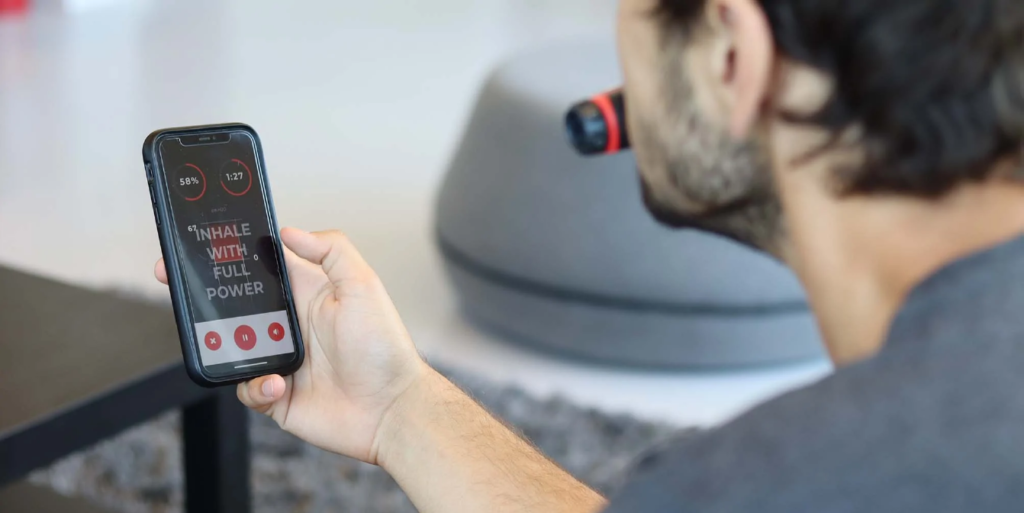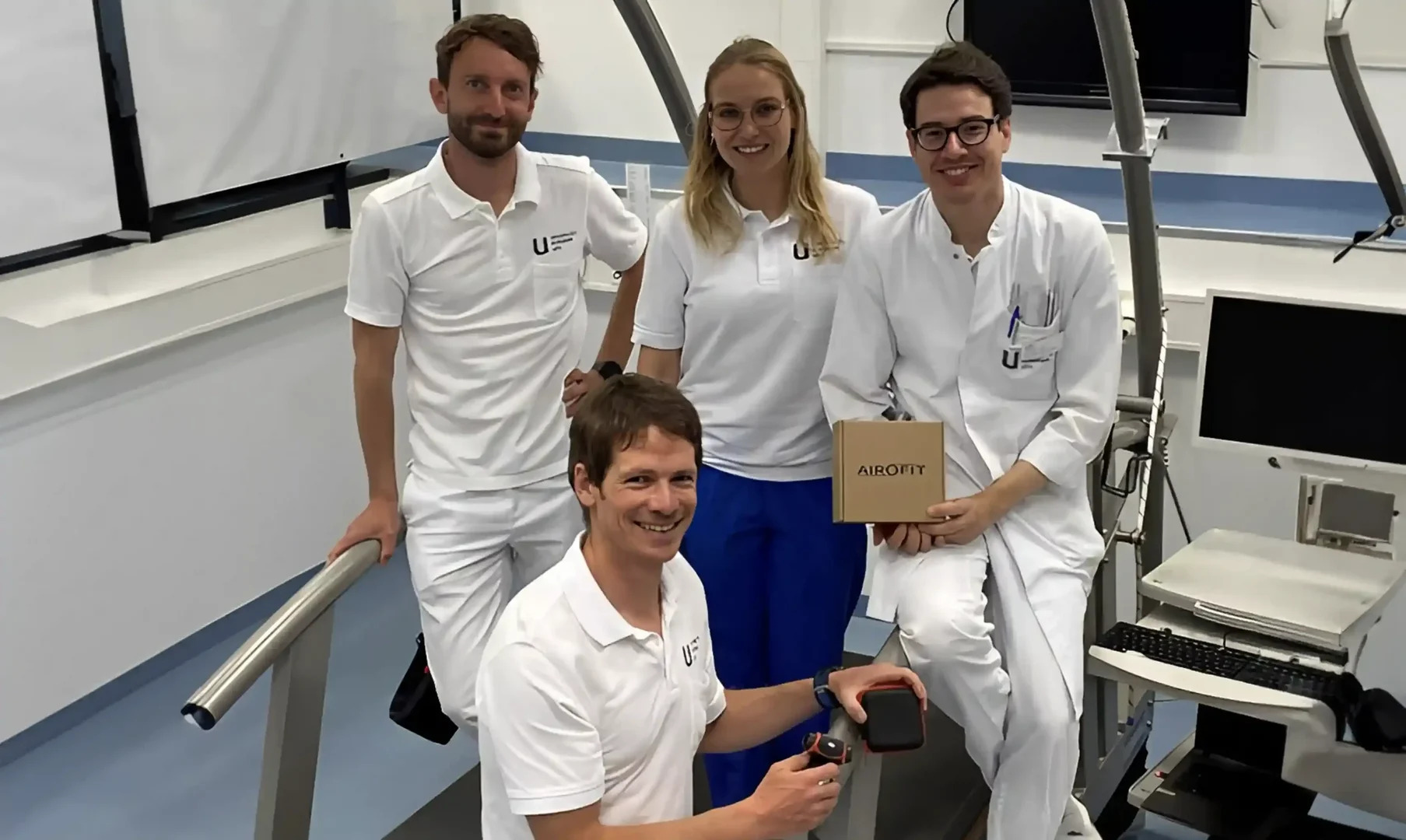- 5 min read
- February 22, 2023
Elite swimmer reveals the benefits of respiratory muscle training

Swimming is a great way to stay fit and enjoy regular aerobic physical activity. You may gain lots of health benefits from swimming, such as stress alleviation, maintaining a healthy weight, and strengthening your heart and lungs. Apart from this, it is also suitable for those who have arthritis and other pain conditions.
According to the Centers for Disease Control and Prevention
(https://www.cdc.gov/healthywater/swimming/swimmers/health_exercise.html)
, swimming for just 2.5 hours per week decreases the risk of chronic illnesses.
It’s no wonder that swimming is the fourth most popular sports activity in the United States.
To become a good swimmer, proper breathing is a must.
Here are 5 benefits of breathing muscle training proper breathing for swimmers revealed by NCAA Division 1 swimmer Sebastian Tullberg Poulsen
(https://www.sn.dk/rudersdal-kommune/fotoserie-denne-dims-kan-redde-ditliv/), gold-winner of the Danish Open 2019 in the senior category and a multiple-time winner of the Nordic Junior Championships 2016, (from where Sebastian came home with seven gold and one silver medal in the short and medium distances.)
1.More energy

Better breathing means better oxygen flow to your muscles during exercise, reducing fatigue.
The cells in your body use the oxygen you breathe to get energy from the food and drinks that you consume. During this process, the cells use oxygen to break down sugar in order to produce the energy your body needs to function during exercise.
With efficient breathing muscles and correct breathing patterns, you can optimize oxygen uptake in your muscles.
This is due to something called Metabolic Reflex. It’s a basic physiological function that regulates your ability to perform a physical exercise at a sustainable rate.
When you reach your lactic acid threshold in a particular muscle, your nervous system sends a signal to your brain to begin vasoconstriction – a reduction in the diameter of blood vessels in the active limb muscles. This is your body saying
When you reach your lactic acid threshold in a particular muscle, your nervous system sends a signal to your brain to begin vasoconstriction – a reduction in the diameter of blood vessels in the active limb muscles. This is your body saying
“You have hit your limit, so we are going to slow down now.“
Once your breathing muscles tire, the effect is the same. However, isolated respiratory muscle training makes them stronger, faster and more efficient. This delays the onset of the metabolic reflex, or abolishes it altogether so breathing is no longer a limiting factor in your performance!
2.Increased accessible lung capacity
Vital lung capacity is the amount of air exhaled after maximum inhalation. While theoretically this capacity is finite, you aren’t accessing the whole vital capacity. Instead, we call it Accessible Vital Lung Capacity. For swimmers, increased lung capacity will mean that you can execute better underwater during training and competition, which is a critical part of fast swimming.
Airofit improves the range of motion in your diaphragm, which reduces the residual volume of the lungs and allows you to inhale more usable air. As a result, you can go longer between breaths while swimming.
See what a swim coach thinks about the importance of a higher accessible lung capacity:
3. Faster swimming times in races.
Specific breath-hold exercises will teach you to find comfort in keeping your head under water. Most often when you feel like you’re running out of breath, your body is actually trying to exhale to get rid of the CO2 buildup. However, CO2 actually helps with O2 absorption. Once you become comfortable with your breath-holds, your muscle oxygenation will improve. These improvements will result in better performance and speed in races, especially sprints.
Airofit builds strength and flexibility in your diaphragm and intercostal muscles to ensure you don’t waste unnecessary energy on breathing. Regular training also increases the mobility of the thorax joints (in your ribs & spine).
“During the last 1.5 years, I was doing different breathing exercises with Airofit, which were helping me to reach different swimming training goals. For example, when I was going to swim in a short-course competition, I used a lot of breath-hold exercises because around 50% of the race was underwater, and I had to do a lot of underwater kicking and swimming. And I should say that with Airofit I could tolerate more, and I could go for longer.”
4. Improve the flexibility of your upper body
The upper body is critical in swimming. Maintaining a proper range of motion throughout the joints and building strength will help you to enjoy the sport of swimming for many years to come.
“With Airofit you can improve the flexibility of your upper body. It is vital for swimmers. Practicing different breathing patterns will teach you how to breathe, and it will also shape your body in the way that fits your discipline the most. Therefore, in the beginning, I have focused on the Respiratory strengths. As it helped me to stabilize my core, and I also added resistance to my breathing.”
5.Focus, stress relief and relaxation

Mental health and general wellbeing can also be one of the areas, which can be sufficiently enhanced while doing the breathwork.
Some of the most obvious breathing benefits for swimmers will be lower anxiety and strengthening of the focus before the big championship final.
“When I was 15 or 16 years old, I tended to get very nervous while attending the big races, and I felt that if I would pay too much attention to my breathing, it would just become worse… To cope with stress, I was trying to take bigger breaths because I felt that I didn’t get enough oxygen, and in the end, I was starting to yawn. I was undersaturated and breathing wrongly.”
Using certain breathing exercises can help swimmers to cope with anxiety and support them in focusing on the goal while slowing down their heart rate and diverting focus to their breathing.
Airofit provides a simple and easy way to interact with your breathing. When working with the device, you will start to pay more attention to how your breath enters and exits the body, bringing a deeper awareness and helping you slowdown, providing you with balance and positive energy with every breath.
“I have learnt to relax my body better also by doing some special breathing exercises with Airofit. I normally go with the Single relaxation sessions and try to follow the relaxation breathing pattern. Doing 1 or 2 sessions in the evening works well for me. I can fall asleep in 5-10 minutes.”
Exercising in water is a good choice for people who want to be more active. As breathing is a vital part of it, learning how to breathe properly will help you enjoy the most of the swimming activity and experience all the physical and mental health benefits.
If you want to learn more about the breathing benefits of swimming,
read more here (https://airofitweb.cometdigisol.com/swimming/).
#StayABreathAhead



